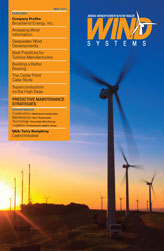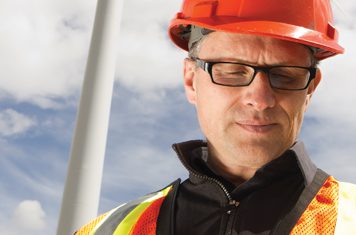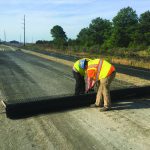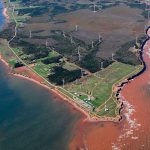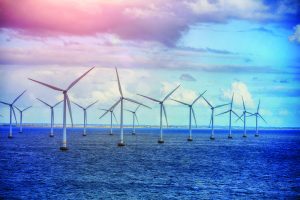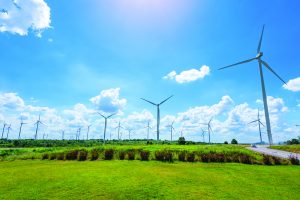The wind industry faces a number of challenges in developing wind farms, both onshore and offshore. Two that concern the aerodynamics of wind turbines are wind siting accuracy over complex terrain onshore and air/wave interaction offshore, and power forecasting for wind turbines to streamline transmission into electrical grid with minimal losses. These difficulties are even further amplified when wind turbine wakes interact directly with turbines located downstream in a turbulent atmospheric boundary layer (see figure). The accurate prediction of power extraction of wind turbine arrays such as in modern wind power plants is essential to the feasibility, reliability, and credibility of wind-produced energy.
A typical wind turbine wake is composed of three regions. One can identify a “near wake” that typically extends two to three rotor diameters downstream of the actuator disk and is governed by near-field viscous three-dimensional flow with wake expansion and an associated pressure increase. An “intermediate wake” where pressure and centerline velocity remain constant and a turbulent mixing layer reaches the centerline at the end of this wake region at about seven rotor diameters. A “far wake” region in which turbulent mixing now increases the centerline velocity recovery at approximately constant pressure. The fact that the pressure appears to remain constant in the intermediate and far wakes gave rise to assuming that downstream turbines do not affect the inflow of their upstream counterparts, thus leading to computationally more efficient “parabolized” methods.
 Today there are a number of wind turbine wake codes available that are primarily based on theory and standards developed in the 1980s. The very first models for wind farms considered wind turbines as distributed surface roughness elements in a logarithmic velocity profile model of the Atmospheric Boundary Layer (ABL). This concept was widely used in the early days of wind energy in the 1970s but is hardly used anymore today. However, these early approaches identified the two most important factors influencing wind turbine array efficiency, i.e. wind turbine location and atmospheric turbulence. Simple superposition of one-dimensional momentum deficits served as initial estimates. A more rigorous approach was pursued in the so-called “kinematic models,” where a linear superposition of self-similar velocity deficit solutions based on models for co-flowing jets was utilized with the turbine thrust coefficient determining the initial velocity deficit. These kinematic models have their limitations and cannot include ground effects of complex terrain sites or interaction with sea waves offshore. More recent models are the “field models” based on the parabolized Navier-Stokes equations. A variety of closure models have been developed in RANS and LES to represent the behavior of the small scales. Different modeling issues here include the “inflow modeling” (ABL profiles from empirical methods and/or mesoscale weather prediction codes), the “wake modeling” (axi-symmetric, Gaussian velocity profile, Lagrangian vortex particle wake, RANS, etc.), and the “rotor modeling” (actuator disk, line, and surface methods that model the action of wind turbine blades on a RANS or LES flow with the use of the body-force concept).
Today there are a number of wind turbine wake codes available that are primarily based on theory and standards developed in the 1980s. The very first models for wind farms considered wind turbines as distributed surface roughness elements in a logarithmic velocity profile model of the Atmospheric Boundary Layer (ABL). This concept was widely used in the early days of wind energy in the 1970s but is hardly used anymore today. However, these early approaches identified the two most important factors influencing wind turbine array efficiency, i.e. wind turbine location and atmospheric turbulence. Simple superposition of one-dimensional momentum deficits served as initial estimates. A more rigorous approach was pursued in the so-called “kinematic models,” where a linear superposition of self-similar velocity deficit solutions based on models for co-flowing jets was utilized with the turbine thrust coefficient determining the initial velocity deficit. These kinematic models have their limitations and cannot include ground effects of complex terrain sites or interaction with sea waves offshore. More recent models are the “field models” based on the parabolized Navier-Stokes equations. A variety of closure models have been developed in RANS and LES to represent the behavior of the small scales. Different modeling issues here include the “inflow modeling” (ABL profiles from empirical methods and/or mesoscale weather prediction codes), the “wake modeling” (axi-symmetric, Gaussian velocity profile, Lagrangian vortex particle wake, RANS, etc.), and the “rotor modeling” (actuator disk, line, and surface methods that model the action of wind turbine blades on a RANS or LES flow with the use of the body-force concept).
Though significant advancements are currently being pursued, difficulties remain in a physically correct representation of actuating devices—i.e. the wind turbine blades—within a RANS or LES solver of the background ABL flow that satisfies the conservation laws of mass, momentum, energy, and circulation, or vorticity. Available field measurements show large data scatter that question the physical correctness of comparisons between data and predictions. There is the need for a hierarchical yet unified and general actuator blade model rooted in the physical conservation laws. We need some innovative modeler minds and hope that DOE’s recent Funding Opportunity Announcement (FOA) will award new ideas that go beyond adjusting present predictive tools.
















